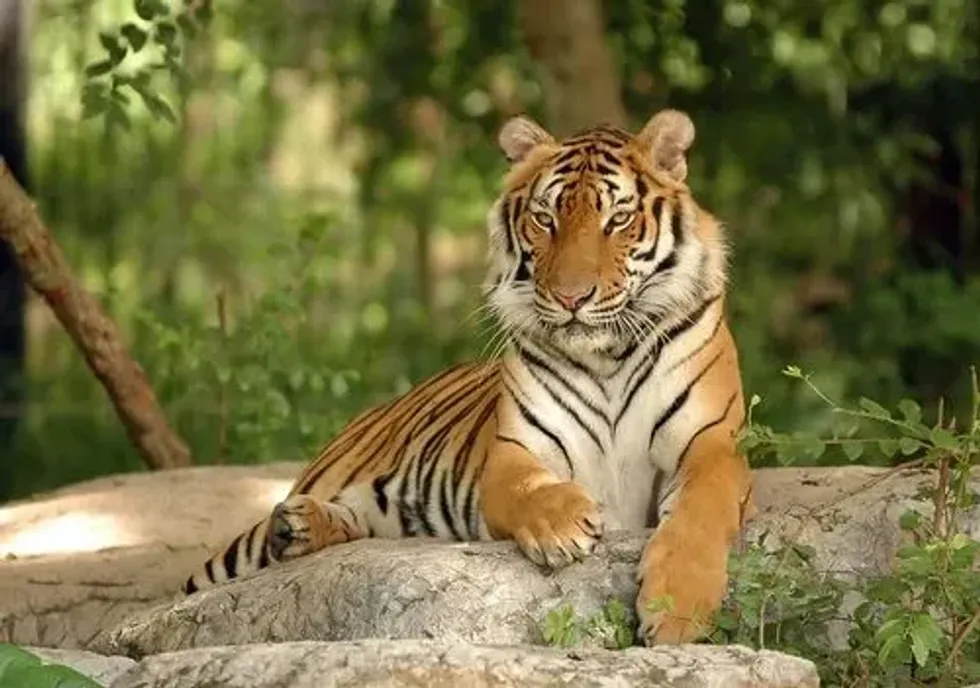The Indochinese tiger (Panthera tigris) is an endangered animal that is native to countries in Southeast Asia such as Cambodia, Laos, and more. Since 2008, the Indochinese tiger Panthera tigris' conservation status has been listed as endangered.
Its rapidly declining population is inching it closer to the critically endangered status. Before the scientific name of these tigers was decided as Panthera tigris tigris, Czech biologist Vratislav Mazak proposed the scientific name Panthera tigris corbetti.
Even though the tiger Indochinese tiger has a lot of similarities to the Bengal tiger in terms of physical traits, there are some differences that make it unique. For example, its skull is smaller compared to that of the Bengal tiger.
We'll take you through some of the most interesting and thought-provoking facts about the Indochinese tiger. We'll touch on sensitive subjects such as the number of Indochinese tigers left along with its habitat and a lot more.
So, if you've always had an interest in tigers, read on! For more amazing facts-based articles right here on Kidadl, check out Asiatic lion and plains zebra.
Indochinese Tiger Interesting Facts
What type of animal is an Indochinese tiger?
The Indochinese tiger is part of the tiger family, found in parts of South East Asia.
What class of animal does an Indochinese tiger belong to?
The Indochinese tiger is part of the mammal family in the animal kingdom.
How many Indochinese tigers are there in the world?
The exact number of Indochinese tigers is unknown. However, estimates since the late 2000s have stated that in all probability, there are less than 1500 Indochinese tigers left in the wild. One of the saddest Indochinese tiger facts is that the total population is decreasing rapidly due to illegal poaching.
Where does an Indochinese tiger live?
Indochinese tigers are found in the woods of South East Asia.
What is an Indochinese tiger's habitat?
At present, the highest number of Indochinese tigers is present in Laos, Thailand, and Myanmar. Sightings have been reported in Cambodia and Vietnam as well.
However, there are no more Indochinese tigers left in China, where tigers have been poached for making Chinese traditional medicine.
The highest population of Indochinese tigers in Myanmar is in regions such as the Htamanthi Wildlife Sanctuary, the Hukawng Valley, and the Tanintharyi Region. In Thailand, most of the Indochinese Tiger population is sheltered in the Western Forest Complex, which includes the Huai Kha Khaeng Wildlife Sanctuary.
This particular habitat is one of the subtropical and tropical moist broadleaf forests.
Sightings of both adults and cubs have also been reported in the Pang Sida National Park, Thap Lan National Park, Dong Phayayen-Khao Yai Forest Complex, and Dong Yai Wildlife Sanctuary. In Laos, sightings of the tigers have been reported in the Nam Et-Phou Louey National Protected Area.
Who do Indochinese tigers live with?
Indochinese tigers live on their own, a solitary life.
How long does an Indochinese tiger live?
Indochinese tigers live for around 18-25 years, depending on their diet, health and habitat.
How do they reproduce?
Indochinese tigers, like most other mammals, rely on the means of sexual reproduction to produce offspring. Typically, males and females only come together during mating seasons, as most Indochinese tigers are solitary beings.
Males and females reach their sexual maturity at different ages, with females becoming receptive to mating after 3-4 years and males after 4-5 years. Females are known to discharge urine that has a particular odor and make certain sounds to attract males when they're ready to mate.
Before mating commences, both males and females engage in a ritual where they circle one another or perform vocalizations. Intercourse happens several times over a 5-6 day period.
For breeding to be successful, the gestation period has to last for around 103 days. Typically, 3 - 5 cubs are born if breeding is successful.
What is their conservation status?
The current conservation status of the Indochinese tiger (Panthera tigris) is Endangered.
Over the years, their population has gone through a swift decline. While there have been efforts across Southeast Asia to conserve this unique subspecies, destructive activities of humans, including activities leading to habitat loss and illegal poaching, continue to be rampant.
Experts suggest that the day isn't far when the loss of habitat and uncontrolled illegal poaching lead to this tiger subspecies becoming critically endangered.
The subspecies has suffered particularly in China, where the poaching of tigers to create traditional medicine is an old practice. Right now, the subspecies has become totally extinct in China, and numbers continue to go down, with no reported sightings in Cambodia in the last few years.
However, Thailand continues to be a safer haven for the remaining tigers than Cambodia and Vietnam, and there still is hope if conservation efforts are increased going into the future.
Indochinese Tiger Fun Facts
What do Indochinese tigers look like?
If you spot a tiger Indochinese from a distance, you probably wouldn't be able to make out much of a difference between it and the more famous Bengal tiger. However, if you manage to get closer, you'll get to see that the head of an Indochinese tiger is a bit smaller compared to that of a Bengal tiger.
There are differences between the Bengal and Indochinese tigers in terms of color as well.
The shades of yellow to brown fur are much darker when it comes to Indochinese tigers. The stripes are narrower as well.
How cute are they?
Indochinese tigers are among the most majestic-looking tigers in the world. However, they are carnivorous, which means that they can be dangerous for humans, especially if they've not had much to eat and are hungry. Indochinese tiger cubs, on the other hand, are incredibly cute. Indochinese tigers usually sleep on their stomach or side.
How do they communicate?
Like all tigers, the Indochinese tiger also relies on a variety of communication forms. As mentioned before, they perform vocalizations during the mating season. They also roar during fights with large prey and to call out to their cubs.
They also make chuffing sounds when they are friendly. This species also uses its tail to communicate.
For example, if the species feels relaxed, its tail appears as hanging loosely. However, if its tail is moving and twitching, it communicates its aggression. Both males and females use urine to mark their territories.
How big is an Indochinese tiger?
Compared to a domestic cat, which is typically around 23-25 cm long (head-to-body length), an Indochinese tiger is at least 10 times bigger.
How fast can an Indochinese tiger run?
The top speed of an Indochinese tiger in the wild is approximately 60 miles per hour.
How much does an Indochinese tiger weigh?
The weight of Indonesian tigers varies from male to female. On average, males of this species weigh around 150-195 kg (331-430 lb) and females weigh 100-130 kg (220-290 lb).
What are their male and female names of the species?
There are no gender-specific names of the Indochinese tiger. Adults are referred to as tigers while the newborn are referred to as cubs.
What would you call a baby Indochinese tiger?
You would call a baby Indochinese tiger a cub.
What do they eat?
Now that we've mentioned at length regarding the Indochinese tiger habitat, it's time to take a look at the Indochinese tiger diet. In the 2013-2015 period, 150 kill sites were reported from regions with significant populations and 11 prey species were identified.
They included animals such as the wild boar, gaur, banteng, sambar deer, hog badger, Asian elephant calves, muntjac, Old World porcupine, langur, pangolin, and serow.
Are they dangerous?
In the wild, Indonesian tigers are fast and ferocious and if they're hungry, they have the power and cunning to take on the biggest of prey. So yes, they can be quite dangerous.
Would they make a good pet?
It's almost impossible to adopt an Indochinese tiger. Their endangered conservation status makes it difficult to adopt them due to environmental protection laws. And it's best to let these beautiful beasts remain in the wild as it can be incredibly difficult to accommodate a wild tiger at home.
Did you know...
The scientific name of the Indochinese tiger was given in honor of famous British naturalist Jim Corbett.
Why is the Indochinese tiger endangered?
Rapid loss of habitat and illegal wildlife trade are the biggest contributors to the decreasing numbers of Indochinese tigers in Southeast Asia. It is one of the saddest but true Indochinese tiger animal facts.
Does the Indochinese tiger have any predators?
In the wild, adult Indochinese tigers have no predators. However, if a cub gets isolated, bigger animals may pose a threat to it.
Its only real predators are humans, whose activities are leading to an ever-decreasing population. We hope that this article made you aware about the plight of the Indochinese tiger.
If it made a lasting impression on you, we encourage you to spread awareness about the Indochinese tiger and other endangered and critically endangered animal species remaining in the world today. It's only through awareness and action that human beings can undo the negative effects of our activities that are rapidly destroying nature.
Here at Kidadl, we have carefully created lots of interesting family-friendly animal facts for everyone to discover! Learn more about some other mammals including South China tiger, or Siberian tiger.
You can even occupy yourself at home by drawing one on our Indochinese tiger coloring pages.










